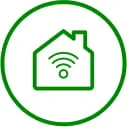As we plunge headfirst into a hyperconnected present and future, a solid, fast, reliable internet connection built to handle the bandwidth needs of multiple connected devices is becoming more critical.
Fiber-optic internet is the gold standard of connectivity. Using pulses of light to transmit massive amounts of data over long distances, this form of internet connection has become mainstream for residential use and may eventually replace traditional cable connections.
But do you need fiber internet? Is there a reason not to switch to this overall better product? While fiber is an excellent choice for most users, it’s worth considering the potential drawbacks before making the switch.
Availability
One issue with fiber internet is that it’s slow to build out. Cable and DSL infrastructure has existed for a long time, and satellite internet just requires some equipment pointed at the sky. This isn’t a downside to the technology but rather the availability. If you’re in a rural area, fiber may not be an option that’s even on the table for you for a while.
The fix: If fiber isn’t available in your area yet, consider signing up for alerts with any regional internet service providers. They’ll update you as the fiber build gets closer to your area. Because building out fiber is an involved process, especially if the fiber needs to be laid underground, even after the process starts it could take several months before it becomes available to individual homes. You could also be the squeaky wheel — check in with local government officials periodically to find out if developments are underway. Local governments need to cooperate with ISPs to issue permits and help the projects succeed.
Cost
Installing fiber infrastructure can be costly. While many providers cover the installation fee for residential customers, businesses — especially those in remote locations — might face steep costs to bring fiber to their premises. Even with subsidized residential installation, the monthly costs for fiber plans may be higher than some cable or DSL options.
The fix: If there’s competition in the market, you’re likely to be able to shop around for the lower price. Take advantage of any specials, but be aware that your introductory pricing will come to an end. Consider fiber an investment in the future of internet technology. In the long run, you’ll have faster speeds and fewer disruptions. Importantly, fiber is built to last and won’t require costly upgrades in the years to come. Another factor to consider is that fiber connectivity can increase property values, so if selling is in the future for you, that could potentially boost your sale price.
Potential for overkill
Do you really need lightning-fast internet speed? While its symmetrical speeds and low latency certainly can make a difference for remote workers, serious gamers, hardcore streamers or content creators, if you’re not so much of an online person, you may just not need to invest in this right now. If your internet usage consists of casual browsing, checking emails, and streaming in HD, you might not notice a dramatic difference compared to a high-speed cable connection. Also, if you’re attached to your cable TV routine, keeping a cable bundle for internet, phone and TV may be a comfortable choice. If it’s not broke, don’t fix it, right?
The fix: Assess your internet needs before upgrading. Will you be increasing your internet needs, perhaps with an adult child moving home, a new roommate situation, or a remote work option? Fiber may still be a great alternative to cable: fiber plans without bundles can be less expensive than cable bundles, and you can still stream all your favorite programs with apps like YouTube TV, or you can supplement your streaming options with a small antenna.
More upsides than downsides
While fiber internet may have some potential downsides, these drawbacks tend to be within your control. For users who need fast, reliable internet — whether for work, gaming or streaming — the benefits of fiber far outweigh the reasons for hesitation.
Remember, the future of connectivity is fiber, so even if it’s not perfect for you today, its value will only grow as technology and infrastructure evolve.






